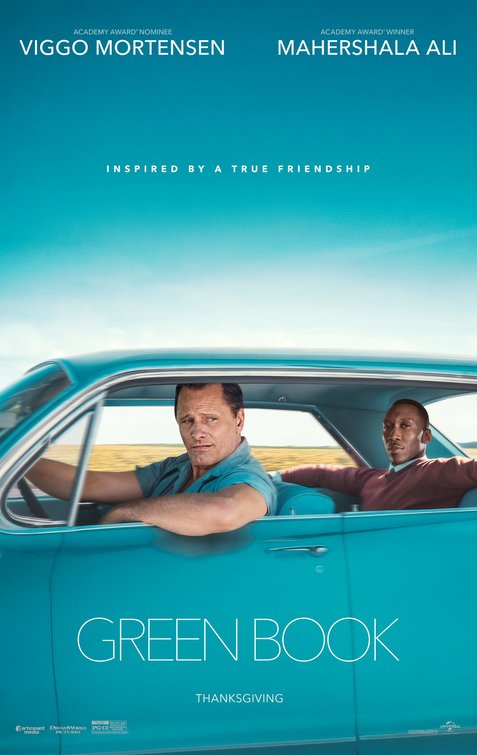Inspired By A True Friendship
Director
Peter Farrelly
Starring
Viggo Mortensen
Mahershala Ali
Linda Cardellini
During the early 60s, Frank ‘Tony Lip’ Vallelonga [Mortensen] is working as a bouncer for a New York nightclub. As an Italian American, he has a past with organised crime but largely keeps out of it for his family’s sake. Either way, he’s a heavy and has a simple set of skills. We are then introduced to Don ‘Doc’ Shirley [Ali], an extremely talented pianist who lives above Carnegie Hall and needs a chauffeur to take him on an eight week tour of destinations in the deep south, who still have deep-rooted prejudices concerning African Americans. Tony reluctantly accepts the job and is given the Green Book (a guide to safe spots to stay, eat and drive for black tourists visiting the southern States). Along the way, there are distinct personality clashes between the refined and well-mannered Shirley and the abrasive but loveable Vallelonga.
I appreciate I’ve just summarised the plot but if you’ll humour me a moment, I would like to post two separate storylines to you. The first is about a highly educated African American musician taking a tour of venues in the deep south during the early 1960s. The second is about a fairly bigoted but charming Italian American who drives an artist through territory hostile to him. While both are compelling, one clearly stands out as the more interesting source for drama, tension, humour and poignancy. I would then ask which of those two individuals would you say is the lead character? And this is Green Book’s biggest flaw but we’ll come back to that properly later. The reason a lot of people won’t take issue with this is the performances, which are subtly spectacular. Both Mortensen and Ali have a wonderful amount of charisma and presence that shine throughout the film and from development to development, we not only want them to succeed but we actively want them to become close; much in the way audiences desperately will together a couple in a romantic comedy. As curators of lives, filmmakers that take on biopics or films “based on a true story” have a responsibility to authenticity and accuracy. Having said that, they also have a primary responsibility as entertainers to tell an entertaining and engaging story; after all, this isn’t a documentary. So what we end up with (for better or worse) are clear moralistic caricatures that work well. Sure, the script doesn’t go as far as it could to address the socio-political issues but it highlights enough to allow the co-leads to give us something compelling and heartfelt.
I have always maintained that the best source for dark performances or direction comes from those who have suffered it and try to deflect; in other words, comedians. A life in comedy is one that isn’t chosen lightly, especially if you actually have something to say, and tapping into whatever event or catalyst that prompted said coping method can yield some crushingly earnest performances. We’ve seen this recently with direction from people like Adam McKay who has stepped away from comedy to focus on cutting satire. Now, while the Farrellys have been heavily associated with visceral gross-out humour, there is also the presence of tremendous heart and a tendency to draw an understated focus to how we treat others – usually those with mental health issues. What’s more, directors who come from a comedy background usually know where the line is and have proven they can walk it deftly and that can give them an ability to address certain issues without going too far into the realms of saccharine, cliché or tedious. And while I think Peter Farrelly does this with reasonable skill, he also plays it too safe at times, shying away from some of the most important and powerful talking points; effectively avoiding the peaks and troughs to ensure a level experience.
Over the last few years I have noticed an uncomfortable trend in certain message pieces that breeds a very specific and identifiable formula. Scenes like cops pulling over minorities and mistreating them, black people who have tried to adapt to survive learning about contemporary African American culture from white people and discussions about foods associated with ethnicity are not without their historical merit but they do feel like they are fast becoming hackneyed (solely from a storytelling perspective) which in a way makes them dangerous because it can desensitise the very audiences the filmmakers are trying to educate. It also leaves this movie with an unfortunate summary of “I don’t like them black guys, don’t trust ’em” to “Hey, this black guy is my best friend, you treat him with respect.” Which, considering the script was co-written by Vallelonga’s son, has a bit of lop-sided rose-tinted hero worship. Having said that, while these tropes should be tired, they are still largely unknown for a lot of people, therefore still very important and the performances and direction hold throughout to ensure they play out with the desired well-intentioned effect. Admittedly, there is also an odd sense of closure and optimism by the end of the film. In one particular scene, a policeman pulls Don and Tony over and while we expect more intolerant attitudes, the officer shows genuine compassion and concern but this creates a false statement of “welcome back to the good ol’ tolerant North, where everything is perfect.” I understand why this is done from a narrative point of view but it paints an inaccurate portrayal and runs the risk of invalidating other stories; as if to imply everything worked out just fine. A good contrast is BlacKkKlansman which ends with a sobering contemporary comparison, highlighting that not only were these divisions not resolved back then, they still very much exist today. So for all its intentions and hopes, Green Book ends up less a cutting analysis of America’s past and more a reframing of white alliances by creating another Driving Miss Daisy.
But in spite of that scathing assessment and for all its faults, this film remains a very well-crafted feature but one that feels like it is pitching to a certain section of the audience, in an almost apologetic manner. Who knows? Maybe this is the best way to get through to people and if you can reach someone and make them assess their own attitudes and intolerances, surely that’s a positive step. But it is only a step into a much larger discussion that this film doesn’t really have the weight to hold.
Release Date:
1st February 2019
The Scene To Look Out For:
This is less a statement about a scene that is present but more about scenes that are absent. Cementing the skewing between the two leads, the movie opens with arguably arbitrary scenes of Tony stealing a hat to win a mob boss’ favour, winning an eating contest to make some extra cash for his family and his general uncultured manner with people. All of these serve to highlight the man’s wit, resourcefulness, resilience and desire to take care of his family, as well as his temper getting the best of him and his overall simple nature. But we are given next to nothing about Shirley’s character. In fairness, a lot of this is drawn out over the course of the film, allowing the audience to get to know the pianist as Tony does but even then, everything is shrouded and while that mystery is fine, it feels more like a failing in the scripting phase, rather than an intentional artistic choice.
Notable Characters:
Stepping away from the two leads for a second, the only other standout individual is Linda Cardellini as Tony’s wife Dolores. Again, this is a very clear-cut soft portrayal of a person who is mostly there as a cut-away rather than an actual, fleshed-out human. At the end of the day, she is there to notice and then vocalise the change in Vallelonga’s personality for the better and if I’m honest, Cardellini is wasted in a role that offers so very little.
Highlighted Quote:
“If I’m not black enough and if I’m not white enough and I’m not man enough, then tell me Tony, what am I?”
In A Few Words:
“An extremely enjoyable and charming release which falls short of being as poignant and insightful as it attempts to be”
Total Score: 3/5
![The Red Right Hand Movie Reviews [Matthew Stogdon]](https://reviews.theredrighthand.co.uk/wp-content/uploads/2021/12/cropped-header1.png)




